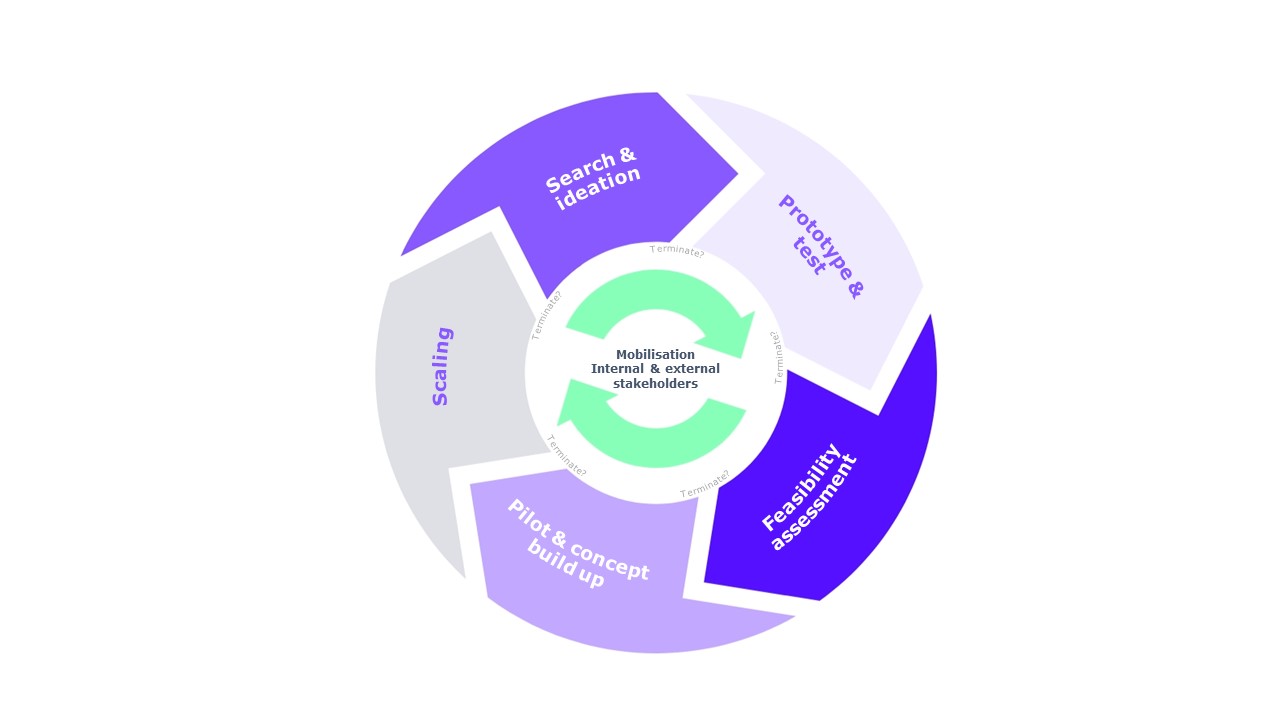WHAT IS INNOVATION?
Innovation is an iterative process of challenging business as usual and doing something new to achieve greater impact.
For the Danish Red Cross innovation is:
To create, try and/or scale something new in a specific context, to seek improved outcomes.
The innovation process
A well-managed innovation process typically follows the below non-linear proces in some shape or form. The innovation process typically has 4-5 phases starting from researching a specific challenges or scouting for a certain opportunity to scaling a well-evidenced impactful solution.
Between each phase in the proces, the project team should evaluate the feasibility with moving on with the proposed solution based on likelihood of impact, potential risks, sustainability and support to the project.
This toolkit is structured according to these phases.
A non-innovation project can follow the same approach in the "initial assessment"-, "planning"- and "implementation phases".

The Mobilisation phase is cross-cutting all phases and extremely important for giving your new project the best conditions to succeed.
NEW WAYS OF WORKING
Innovation is both about how we work and what we do. The ‘how’ is ways of working through certain tools and processes, the ‘what’ is a wide spectrum of concrete solutions.
This toolkit seeks to support and inspire the ‘how’, so we can become better at the ‘what’.
The toolkit is one means to realise the ambition set forth in the Danish Red Cross International Strategy “Ready to Act” 2022-2025:
We commit to reflecting critically on challenges and problems and trying out new or alternative types of solutions and ways of working, when these can bring added value and increase impact for the people we work with and for. We will promote creativity and remain willing to take calculated risks”
STANDARD PROGRAMMING VS. INNOVATION
In most standard programming, the causal pathway between the activities, the outputs and the outcomes are well-understood. It is based on experience, research and evaluations.
When doing something new, we rely on hypotheses until we test them. We are not sure that the idea for improvement will work and achieve the desired results.
To be accountable to the people we serve, we should strive to test and learn what works before longer-term implementation and strive to pivot accordingly as fast and responsibly as possible to reduce risks of doing harm.
The newer the solution, the more attention to accountability, risks and ethics is demanded of us.
.jpg)
NEWNESS OF SOLUTIONS
Innovation is not equal to invention; it may also be to applying an existing solution in a new context. The figure helps translate the spectrum from standard programming to invention.
.jpg)
Solutions can be found along a spectrum starting from incremental improvements, all the way to radical solutions that have the potential for bringing about structural change.
GUIDING PRINCIPLES FOR INNOVATION
In addition to the Fundamental Principles of the Red Cross and Red Crescent Movement and the Core Humanitarian Standards, innovating in the Danish Red Cross is guided by the following principles:
- Design with the User
- Understand the Existing Ecosystem
- Design for Scale
- Build for Sustainability
- Be Data-Driven
- Use Open Standards, Open Data, Open Source, Open Innovation
- Reuse and Improve
- Do No Harm
- Be Collaborative